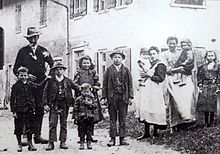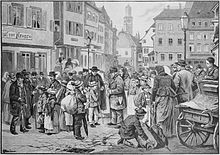Swabian children

As a Swabian or hats children were Bergbauer children from Vorarlberg , Tyrol , of Switzerland and Liechtenstein referred that from the beginning of modern times to the early 20th century, every year because of the poverty of their families in the spring through the Alps to the " Children markets " mainly to Upper Swabia attracted in order to be placed there as seasonal workers , mainly to farmers in rural regions of Württemberg (Upper Swabia and Swabian Alb ), partly also in Baden and Bavaria .
history
poverty
The "Swabian Walk", which was first mentioned in the 16th and 17th centuries, reached its peak in the 19th century. It is estimated that at that time five to six thousand children worked on farms abroad as shepherd boys, maidservants or servants . The reason for this was the extremely low soil yield in the Alpine regions and the associated poverty, which drove the parents to send one or more of their numerous children abroad.
The ways
The ways from Tyrol and Vorarlberg or from Switzerland to Upper Swabia were long and arduous. For some of the mostly 5- to 14-year-old children, it led over mountain passes such as the Arlberg , which were usually still covered by snow in March and which many had to overcome with poor shoes and poor clothing. Usually an adult, sometimes a priest, was their companion who made sure that the children could sleep in warm stables and who negotiated prices in the markets. With the construction of the Arlbergbahn in 1884, travel was made easier for Tyrolean children.
The hat children's markets
The “children's markets” in Upper Swabia mostly took place around Josephi (March 19). At Simon and Judah (end of October) or at the latest on Martini (November 11th) we went back home. In the luggage was the so-called “double hat” (a double set of clothing from headgear to shoes) and a few guilders, depending on the age and the negotiated price.
There were hat children's markets in Ravensburg , Friedrichshafen , Kempten and, if required, in Wangen , Weingarten , Tettnang and Bad Waldsee .
The herding children arrived in the port of Friedrichshafen by ship from Bregenz . Since 1891 the central market place for the hat children has been in Karlstrasse in Friedrichshafen. The children who were not placed took the train to Ravensburg to be placed there.
The work
In their homeland, the Swabian children were exempted from compulsory schooling every year , and in the Kingdom of Württemberg the compulsory schooling there since 1836 did not apply to foreign children. The extension of compulsory schooling, which has repeatedly been politically demanded, was prevented by an Upper Swabian farmers' lobby until 1921.
Tyrolean and Vorarlberg hat children’s association
In 1891 the Tyrolean and Vorarlberg Hütekinderverein was founded by the former pastor Venerand Schöpf and the community leader Josef Anton Geiger from Pettneu am Arlberg to protect the children from arbitrariness. It existed until 1915.
End of child labor
There was a campaign in the US press in 1908 in which, among other things, the children's market in Friedrichshafen was compared with a slave market . The moral indignation was followed by diplomatic activities up to the Reich Chancellery in Berlin, but nothing changed for the children themselves.
The children's markets were abolished in 1915 because the children were now needed at home to replace the soldiers called up in World War I. However, the "Swabian goings" did not decrease rapidly until 1921 after compulsory schooling for foreign children was introduced in Württemberg.
Database of Swabian Children
In the database of Swabian children, the regions of origin, the names of the Swabian children and the employers in Upper Swabia are documented for around 6000 children. The admission locations for the children from individual regions of origin, but also the fate of individual children can be researched in this way.
reception
Literature and film
In the magazine Die Gartenlaube, which was very popular at the end of the 19th and beginning of the 20th century, the children's market in Ravensburg was mentioned as early as 1866 under the title Ein Kinderhandel .
The novel Hungerweg. Von Tirol zum Kindermarkt in Ravensburg (1989) by Othmar Franz Lang tells the story of the Swabian children using an example for young readers. The novel was published in several editions and is also popular as school reading .
The best-known self-testimony of a Swabian child comes from Regina Lampert . The publication of her memoirs of the Swabians. Memories of a Young Maid from Vorarlberg 1864–1874 (1996) brought the topic to general public attention for the first time.
Elmar Bereuter published the novel Die Schwabenkinder in 2002 . The story of the Kaspanaze . A year later, the film was made by Jo Baier under the title Schwabenkinder . The plot differs from the original book.
Exhibitions
The Wolfegg farmhouse museum has a permanent exhibition on the subject; Germany, Italy, Austria as well as Switzerland and Liechtenstein have organized further exhibitions in an EU project.
Hiking trails
In 2012, as part of a cross-border EU project, recording the paths of the Swabian children was started. The recorded routes on the historical paths and paths are available as hiking guides and, in addition to the route descriptions, contain historical facts, experience reports and anecdotes about the living conditions and social backgrounds on site at the time. An introductory section sheds light on the regional background and a recipe collection that can be cooked to familiarize you with the typical regional eating habits.
- Elmar Bereuter: Swabian Children's Paths - Upper Swabia. Bergverlag Rother , Munich 2011, ISBN 978-3-7633-4413-0 .
- Elmar Bereuter: Schwabenkinder-Ways - Vorarlberg (with border areas Tyrol and Liechtenstein). Bergverlag Rother, Munich 2012, ISBN 978-3-7633-4416-1 .
- Elmar Bereuter: Swabian Children's Paths - Switzerland and Liechtenstein. Bergverlag Rother, Munich 2013, ISBN 978-3-7633-4439-0 .
See also
literature
- Regina Lampert : The Swabian woman. Edited by Bernhard Tschofen . Limmat, Zurich 1996, ISBN 3-85791-301-0 (autobiographical records of a "Swabian child" from the time before 1900)
- Otto Uhlig : The Swabian children from Tyrol and Vorarlberg. 4th edition. Universitätsverlag Wagner, Innsbruck 2003, ISBN 3-7030-0320-0 ( Tiroler Wirtschaftsstudien 34), (overall scientific presentation), ( review )
- Sabine Mücke, Dorothee Breucker: Swabian children . Vorarlberg, Tyrolean and Graubünden children as workers in Upper Swabia. Volksbank Ravensburg u. a., Ravensburg 1998 ( Ravensburger Stadtgeschichte 27, ZDB -ID 2072674-0 )
- Siegfried Ruoss: There were many princes and little bread. From scissor grinders, brush binders and other little people in Württemberg. Theiss, Stuttgart 2003, ISBN 3-8062-1770-X
- Loretta Seglias: The Swabians from Graubünden. Seasonal child emigration to Upper Swabia. Kommissionsverlag Desertina, Chur 2004, ISBN 3-85637-297-0 ( Sources and research on the history of Graubünden 13)
- Farmhouse Museum Wolfegg, Stefan Zimmermann, Christine Brugger (eds.): The Swabian Children. Work abroad from the 17th to the 20th century . Südwestdeutsche Verlagsgesellschaft im Jan Thorbecke Verlag, Ostfildern 2012, ISBN 978-3-7995-8047-2 ( table of contents )
For further references see www.schwabenkinder.at/literatur.html
Web links
- Text accompanying the exhibition Schwabenkinder - Vorarlberg, Tyrolean and Graubündner children as workers in Oberschwaben , Ravensburg 1998. In: thomas-scharnowski.de
- Swabian children in the Ausserferner story
- Report on going to Swabia. say.at
- Information about Swabian children and child labor today. schwabenkinder.at
- The Swabian children . schwabenkinder.eu, April 21, 2012
- Thinking sheet on the Swabian children , ed. v. of the Geißstrasse Sieben Foundation .
- Elmar Bereuter's project on the history of the Swabian children and the hiking trails
Individual evidence
- ↑ schwabenkinder.eu hat children's markets
- ↑ Jürgen Oellers: The "Swabian Children from Vorarlberg, Tyrol and Eastern Switzerland". In: Harald Derschka and Jürgen Klöckler (eds.): Der Bodensee. Nature and history from 150 perspectives. In: Jan Thorbecke Verlag, Ostfildern 2018, ISBN 978-3-7995-1724-9 . Pp. 226-227.
- ↑ Jürgen Oellers: The "Swabian Children from Vorarlberg, Tyrol and Eastern Switzerland". In: Harald Derschka and Jürgen Klöckler (eds.): Der Bodensee. Nature and history from 150 perspectives. In: Jan Thorbecke Verlag, Ostfildern 2018, ISBN 978-3-7995-1724-9 . Pp. 226-227.
- ↑ Database of Swabian Children at schwabenkinder.eu
- ^ A child trafficking . In: The Gazebo . Volume 4, 1866, pp. 55–56 ( full text [ Wikisource ]).
- ↑ Jule Schwarz: The Hunger Trail to Wolfegg - On the trail of the Swabian children: New hiking trails. In: Freizeittipps, April 13, 2012. badische-zeitung.de (April 21, 2012)
- ↑ The way of the Swabian children . oberschwaben-tourismus.de (April 21, 2012)



